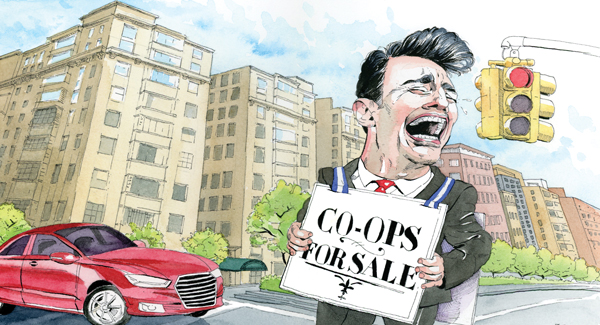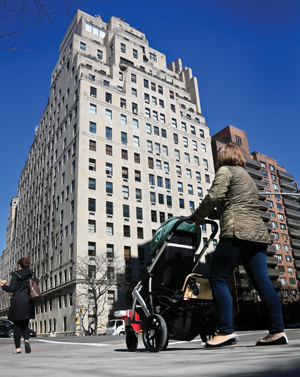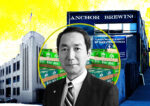Trending
The Upper East Side’s co-op conundrum
With a stuffy reputation and more condo competition, luxe co-ops see sales volume tank 30-plus percent — a sign that the glory days may be over

When ex-hedge fund manager David Ganek and his novelist wife, Danielle, listed their duplex at the fabled Upper East Side co-op building 740 Park Avenue in 2014, they had their sights set on a profit of more than $24 million. The Ganeks paid $19.1 million for the four-bedroom pad, the childhood home of Jackie Kennedy Onassis, in 2005. When they went to sell nine years later, they listed it with a $44 million price tag.
But in July — after three years on the market and several price reductions — the luxurious apartment sold for a muted $25.3 million. Though nearly a $6 million profit, the home still sold at a 43 percent discount from its original asking price.
While price-slashing often represents a seller’s unrealistic expectations, the Ganeks’ case is emblematic of how co-ops, even in the Upper East Side’s marquee buildings, are facing an increasingly tough crowd of buyers. In July, a co-op at 765 Park sold for $19 million, a $7 million discount from what it was first asking in January. In the same month, a full-floor co-op at the Sherry Netherland building at 781 Fifth Avenue had $3 million knocked off its price; it’s now on the market asking $32 million.
The prime Upper East Side neighborhood — which stretches north from East 59th to East 96th streets, and from Fifth Avenue east over to Lexington Avenue — had long been considered the most prestigious place to live in New York City. In the days before Billionaires’ Row, a grand prewar co-op on one of the neighborhood’s avenues was the ultimate trophy property.
“It used to be the only game in town,” said Lisa Lippman, a broker with Brown Harris Stevens who is currently selling a co-op at 111 East 85th Street, which was reduced by 17 percent to $5 million in June. “If you needed a 5,000-square-foot space — a really large, beautiful apartment — your only option was to buy in a fancy building on Park Avenue or Fifth.”
But with new development condominiums springing up all over the city, the Upper East Side’s pricey co-ops are facing stiff competition.
To get a better idea of how the luxury co-op market has been impacted, The Real Deal looked at sales that closed at $5 million and above within the first six months of each of the last six years. While the number of co-op sales peaked in the first half of 2014, and remained steady in the first half of 2017 — hovering between 50 and 60 — dollar volume plummeted 33 percent, from $900 million to $600 million over the same period.
“Everybody wants Downtown, they want condo ownership, and they want contemporary living … it’s a perfect storm,” said Stribling & Associates broker Kirk Henckels, who has worked on the Upper East Side for 35 years. “This is a seismic shift in residential preference. This is not a trend.”
A softening market
Luxury co-ops have been falling out of favor with buyers in the city for years, according to more than a dozen industry sources.
Between the first half of 2012 and the first half of 2017, the number of Manhattan co-op contracts signed at $4 million and above increased 21 percent to 153, while condo contracts at the same price point more than doubled in the same period, hitting 466 in the first half of 2017, data from Olshan Realty shows.
“Some buyers see anything built more than 30 years ago as their grandmother’s apartment,” said Donna Olshan, president of the eponymous residential brokerage.
A closer look at the Upper East Side reflects the neighborhood’s waning appeal. Aesthetics aside, sources largely attributed buyer aversion of the area to the trend toward new development and the general wariness of cagey co-op boards.
 “There are more barriers to entry,” said BHS’s Lippman, who estimates many large co-op units that hit the market need a $4 million to $5 million renovation, a process that is often made more complicated and lengthy by co-op board rules. “If you compare a $20 million apartment on Park Avenue that needs work to a $20 million brand-new apartment, people may want that new apartment because [they won’t need] board approval.”
“There are more barriers to entry,” said BHS’s Lippman, who estimates many large co-op units that hit the market need a $4 million to $5 million renovation, a process that is often made more complicated and lengthy by co-op board rules. “If you compare a $20 million apartment on Park Avenue that needs work to a $20 million brand-new apartment, people may want that new apartment because [they won’t need] board approval.”
Indeed, contracts signed on co-ops have fallen since the market’s peak in 2014. Between Jan. 1 and Aug. 4, 2014, a total of 69 contracts were signed on co-op units priced at $5 million and above, according to data analysis by Stribling. During the same period this year, a total of 44 luxury contracts were signed, a 36 percent decrease. (It should be noted that some contracts signed at more than $15 million are not recorded for privacy reasons.)
Meanwhile, condominiums Downtown are seeing more action. There were 184 contracts signed from Jan. 1 to Aug. 4, 2017, at $5 million and above, a 16 percent increase from 159 during the same time period in 2014, according to Stribling.
“They want the Tribeca trophy properties if they are spending the megabucks,” said Triplemint’s Tyler Whitman. “It’s hard to get someone to spend $3,000 or $4,000 per foot on the Upper East Side.”
Douglas Elliman’s Richard Steinberg echoed that sentiment. “Right now, most people want light, bright and a lot of glass — you don’t get that on the Upper East Side,” he said.
Steinberg is currently listing a $16.3 million co-op unit at 550 Park Avenue, which has been reduced twice and now comes with an increased buyers’ broker commission of 2.5 percent.
The Elliman broker added that he expects there will be a wave of significant price reductions on the high end across the neighborhood after Labor Day. But the price-slashing has already begun. Investor Peter Huang’s 740 Park Avenue duplex has sat on the market for four years. Its asking price was reduced in July to $22.5 million, a 25 percent discount from its original list price. At 1060 Fifth Avenue, former United States ambassador Bruce Gelb tried selling his 15-room co-op for $65 million in April last year, but in June he cut the ask to $38 million.
Even along the Upper East Side’s tonier streets, buyers are showing less interest. In 2014, there were 268 condo and co-op sales on Park Avenue, with a median price of $4.3 million, according to appraisal firm Miller Samuel. By comparison, sales will fall to 204 this year, a nearly 24 percent drop from the 2014 peak, based on year-to-date forecasting data. The median price, meanwhile, will drop to $2.8 million — an approximately 34 percent decrease from the 2014 peak.
Luxury buyers are no longer swayed by the exclusivity and traditional feel of the area, especially since many of those buyers are now far younger than before, Steinberg noted.
“It used to take decades for a family to accumulate wealth to buy on the high-end market, and by the time they were in their 40s or 50s they wanted prewar,” he said. “[Millennials] are not trending toward prewar.”
Price of admission
Upper East Side co-op boards are aware of their sliding appeal, and some are now relaxing their rules to win back buyers who are flocking to new development, the Level Group’s Geraldine Onorato explained.
“Co-ops are getting the memo: If they want to keep their value and their building’s value, they have to re-evaluate the policies,” said Onorato, who is currently working with three buyers who are looking in the area. “What’s really moving on the Upper East Side is everything under $1.5 million, and the less challenging the co-op board, the more desirable the co-op.”
It has been commonplace for some boards to restrict the amount of financing a buyer can use toward the purchase — if financing is allowed at all. The board at 740 Park, for example, reportedly requires buyers to have at least four times the purchase price of the available unit in liquid assets. And quite often, each adult seeking to live in a unit must provide the board with at least four personal references.

740 Park Avenue
But Larry Kaiser, a broker with Berkshire Hathaway HomeServices New York Properties who has sold high-end co-ops on the Upper East Side since the 1960s, said that when it comes to a prospective buyer, co-op boards are less concerned with an individual’s lineage or upbringing.
“The old days are gone, where buildings selected based on who your grandmother was rather than who you were,” he said.
On the flip side, boards have become increasingly focused on a potential buyer’s monetary background, Kaiser noted. “Going way back, everybody knew where the money came from,” he said. “Now, with a lot money coming from different sources, boards are cautious.”
A board’s caution around financials, however, can be a major deterrent for buyers, particularly if they are from overseas, said Triplemint’s GieFaan Kim. Because it’s difficult for a co-op board to trace money through an international entity, a potential buyer’s money already has to be in the States, he said.
And for international buyers, moving money from their home country to kick off a vetting process isn’t preferable — most would only do so if the purchase is a done deal. “The closing process for a condo is far easier for a foreign buyer,” Kim said.
Domestic buyers, too, take that into consideration — especially because it can affect their resale value, Kim said. A co-op’s rules can alienate foreign buyers, who represent roughly 20 percent of residential buyers in Manhattan, according to Miller Samuel.
Elliman’s Sabrina Saltiel, who is marketing a five-bedroom in the Sherry Netherland building for $32 million, said that many buyers prefer the simplicity of buying a condo.
With new development, “you walk in, give your check and you are done,” she said.
“Little black dress”
Along with its established prestige, the Upper East Side’s major selling points are proximity to Central Park and a handful of prestigious institutions — including some of the city’s top public and private schools.
Fifth Avenue’s Museum Mile offers up seven museums. Meanwhile, the Lexington Avenue subway line sits along the neighborhood’s main artery, and high-end stores such as Barneys and Chanel are scattered across the area’s main streets.
“There’s a social cachet of living in these buildings,” said Engel & Völkers’ Christine Miller Martin, who does most of her business in the area. “Raising a kid on the Upper East Side, they will be wearing a jacket and tie — it’s a more formal way of living.”
Kathy Braddock, a William Raveis broker and a lifelong Upper East Sider, pointed to elite private schools like Nightingale-Bamford, the Browning School and Allen-Stevenson, and public schools like P.S. 6, as the reason the area will remain popular. “Is it hip, happening and sexy? No. But these buildings are not empty… there are buyers,” she said.
 But even with those attractions, brokers say the area can be a hard sell.
But even with those attractions, brokers say the area can be a hard sell.
For Miller Martin, the greatest challenge of selling on the Upper East Side is that many of her clients need to invest in decluttering, painting and professionally staging their apartments. Their penchant for older-style furnishings doesn’t always fly with buyers who are accustomed to the sleek look of new developments.
But she thinks that, in many cases, buyers in the area are chasing a timeless, old-world charm. “The Upper East Side is like the little black dress,” Miller Martin said. “It’s never going to go out of style.”
Other brokers agreed, noting there are die-hard Upper East Side fans specifically wanting the prewar look.
“They love the beam ceilings, the fireplaces, the 10-and-a-half foot ceilings, the prewar moldings and herringbone floors,” said Edward Joseph of BHS.
Though Henckels said he believes the neighborhood’s expensive prewar buildings will hold their value, he acknowledged the changing buyer sentiment.
“[A broker] starting out now would be wiser to stake their flag downtown with condos,” he said.
The Far-Upper East Side
Many who are shopping for homes on the Upper East Side are doing so off the neighborhood’s traditional streets. Potential co-op and condo buyers are hoping for a bargain east of Lexington Avenue, and developers have responded to that demand, pushing the neighborhood’s traditional borders to the north, toward Harlem, and to the east, toward the East River.
There are currently 700 new sponsor units in the pipeline for the Upper East Side, according to data from Halstead Property Development Marketing, a subsidiary of Terra Development Marketing. Many of the new buildings are slated for the eastern part of the neighborhood.
Over the past 12 months, the average price per square foot on sold new development units west of Third Avenue was $2,949, compared to an average $1,855 for sold apartments east of Third Avenue, per Halstead’s data.
The buildings located east of Second Avenue are no longer as isolated as they were before the Second Avenue subway opened last year, said Stephen Kliegerman, Terra Development’s president. “If you are willing to come further east, you can get more for your money,” he said.
Some of the biggest new developments in the neighborhood include Related Companies’ Carnegie Park on East 94th Street and Third Avenue, which has an average asking price of $1,888 per square foot, according to StreetEasy. Two avenues east, Anbau Enterprises has been building Citizen 360, which is slated for completion later this year. The 34-story condo tower at East 89th Street has an average asking price of $1,926 per square foot.
“Third Avenue is close to Lexington and Park, [and] buyers coming in see that expansion at Carnegie Hill,” said Extell’s senior vice president of development, Raizy Haas. In 2009, the firm completed the 118-unit Lucida condo tower on East 85th Street and Lexington Avenue, and now, Extell is constructing the Kent on East 95th Street and Third Avenue. “With the Kent, we are expanding the Carnegie Hill border,” Haas said.
Kliegerman stressed, however, that new developers in the area aren’t trying to re-create the prestige of Park and Fifth Avenues.
“Park Avenue has had an identity for over 100 years,” he said. “You can’t create a neighborhood that can directly compete with that, and I don’t think anyone is under any illusion that the far east is going to equate to the Gold Coast.”




